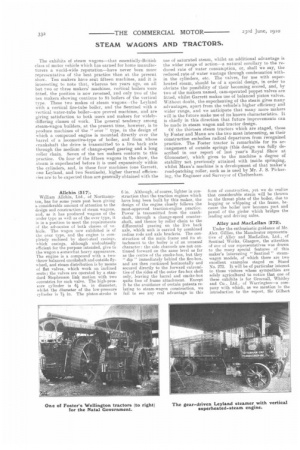STEAM WAGONS AND TRACTORS.
Page 16

If you've noticed an error in this article please click here to report it so we can fix it.
The exhibits of steam wagons—that essentially-British class of motor vehicle which has earned for home manufacturers a world-wide reputation—have never been more representative of the best practice than at the present show. Ten makers have sent fifteen machines, and it is interesting to note that, whereas ten years ago, on all but two or three makers machines, vertical boilers were fitted, the position is now reversed, and only two of the ten makers showing continue to fit boilers of the vertical type. These two makes of steam wagons—the Leyland with a vertical fire-tube boiler, and the Sentinel with a vertical water-tube boiler—are proved machines, and are giving satisfaction to both users and makers for widelydiffering classes of work. The general tendency among steam-wagon builders, at the present time, however, is to produce machines of the " over " type, in the design of which a compound engine is mounted, directly over the barrel of a locomotive-type of boiler, and from whose crankshaft the drive is transmitted to a live back axle through the medium of change-speed gearing and a long roller chain. Seven of the ten makers conform to this practice. On four of the fifteen wagons in the show, the steam is superheated before it is used expansively within the cylinders, and, in these four machines (one Garrett, one Leyland, and two Sentinels), higher thermal efficiencies are to be expected than are generally obtained with the use of saturated steam, whilst an additional advantage is the wider range of action—a natural corollary to the reduced rate of water consumption, or, shall we say, the reduced rate of water wastage through condensation within the cylinders, etc. The valves, for use with superheated steam, should be of a special design, in order to obviate the possibility of their becoming scored, and, by two of the makers named, cam-operated poppet valves are fitted, whilst Garrett makes use of balanced piston valves. Without doubt, the superheating of the steam gives many advantages, apart from the vehicle's higher efficiency and wider range, and we anticipate that many more makers will in the future make use of its known characteristics. It is chiefly in this direction that future improvements can be made in steam wagon and tractor design. Of the thirteen steam tractors which are staged, those by Foster and Mann are the two most interesting, as their construction embodies radical departures from recognized practice. The Foster tractor is remarkable for its arrangement of outside springs (this design was fully described in our report of last year's Royal Show at Gloucester), which gives to the machine a degree of stability not previously attained with inside springing, whilst Mann's machine is a development of that maker's road-patching roller, such as is used by Mr_ J. S. Pickering, the Engineer and Surveyor of Cheltenham.
































